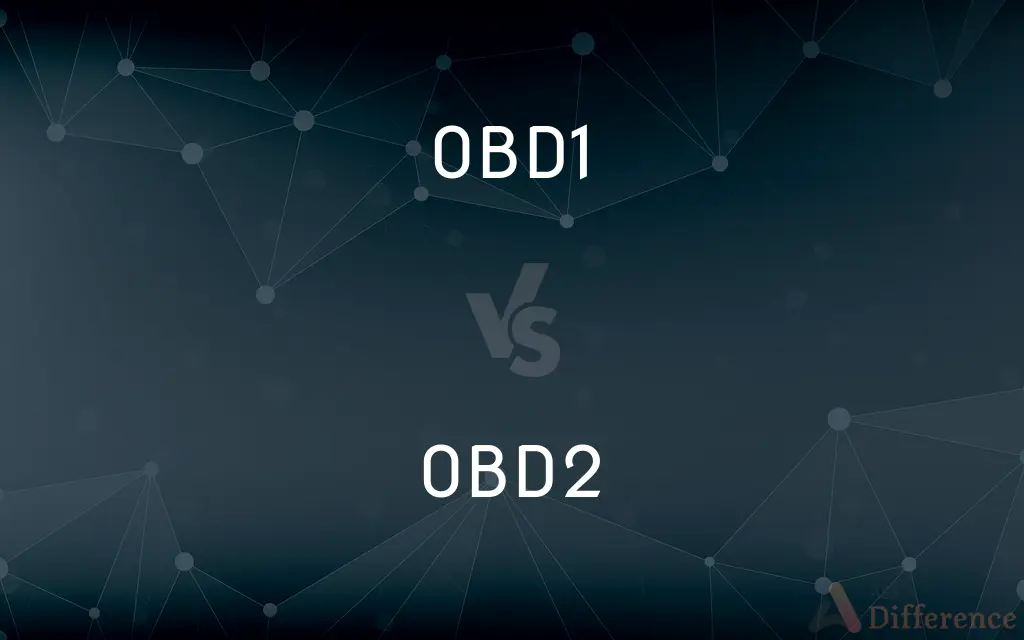OBD1 vs. OBD2 — What's the Difference?
By Tayyaba Rehman & Maham Liaqat — Published on September 24, 2024
OBD1 is an early diagnostic system focusing on basic vehicle data, while OBD2 offers a standardized, more detailed analysis of car performance and emissions.

Difference Between OBD1 and OBD2
Table of Contents
ADVERTISEMENT
Key Differences
OBD1, the first generation of On-Board Diagnostics, provided basic troubleshooting capabilities for vehicles, primarily through manufacturer-specific connectors and codes. It was an initial step towards understanding vehicle health but lacked standardization across different car brands.
OBD2, introduced in the mid-1990s, represents a significant advancement in diagnostic technology. It standardized diagnostic systems across all vehicles sold in the United States, making it easier for technicians and owners to diagnose and troubleshoot problems.
OBD1 systems were limited in their scope, offering basic fault codes and data, while OBD2 systems provide comprehensive vehicle diagnostics. This includes real-time data, a universal connector, and standardized trouble codes that facilitate the identification and resolution of a wide range of vehicle issues.
The transition from OBD1 to OBD2 also marked a shift towards better emission control and monitoring. OBD2 systems are capable of running continuous checks on the vehicle's emission system, ensuring compliance with environmental standards.
Despite their differences, both OBD1 and OBD2 systems serve the fundamental purpose of diagnosing and reporting vehicle problems. However, OBD2's enhanced capabilities and standardization make it a more effective tool for modern vehicles, emphasizing the evolution of automotive diagnostics over time.
ADVERTISEMENT
Comparison Chart
Introduction Year
1980s
Mid-1990s
Standardization
Manufacturer-specific
Universal across all vehicles sold in the US
Diagnostic Connector
Varies by manufacturer
Standardized 16-pin connector
Data Access
Limited vehicle data and fault codes
Comprehensive vehicle diagnostics and real-time data
Emission Control
Minimal emphasis on emission monitoring
Continuous emission monitoring and control
Compare with Definitions
OBD1
Primarily pre-1996 vehicles.
Most cars made before 1996 use the OBD1 system for diagnostics.
OBD2
Offers detailed vehicle analysis.
OBD2 systems can monitor emissions in real-time, ensuring compliance.
OBD1
An early vehicle diagnostic system.
The mechanic used an OBD1 reader to diagnose the older model car.
OBD2
Universal connector across vehicles.
The 16-pin OBD2 connector fits any car model from 1996 onwards.
OBD1
Manufacturer-specific connectors.
Finding the right OBD1 connector for each car brand can be a challenge.
OBD2
Enhanced diagnostic capabilities.
OBD2 provides more data points and codes for comprehensive troubleshooting.
OBD1
Limited in scope and functionality.
OBD1 systems provide fewer data points about vehicle health.
OBD2
A standardized vehicle diagnostic system.
The OBD2 scanner quickly identified the emission problem.
OBD1
Focuses on basic troubleshooting.
With OBD1, identifying the engine problem required decoding manufacturer-specific codes.
OBD2
Mandatory for all US cars sold from mid-1990s.
Every car sold in the US after 1996 must have an OBD2 system.
Common Curiosities
How do OBD1 and OBD2 differ in standardization?
OBD1 systems are manufacturer-specific, while OBD2 systems are standardized across all vehicles sold in the US.
What is OBD1?
OBD1 is the first generation of On-Board Diagnostics systems, offering basic vehicle diagnostic capabilities with manufacturer-specific standards.
Are OBD1 and OBD2 compatible?
No, OBD1 and OBD2 use different connectors and protocols; they are not compatible.
What is OBD2?
OBD2 is a standardized diagnostic system used in all vehicles sold in the US from the mid-1990s, providing comprehensive vehicle diagnostics.
What kind of data can OBD2 systems provide?
OBD2 systems can provide real-time data, standardized fault codes, and continuous emission monitoring.
What are the benefits of OBD2 over OBD1?
OBD2 offers greater diagnostic capabilities, standardization, and improved emission monitoring compared to OBD1.
How do I know if my car is OBD1 or OBD2?
Cars manufactured before 1996 are typically OBD1, while those from 1996 onwards are OBD2.
Can OBD1 connectors be used on OBD2 systems?
No, OBD1 connectors are different and cannot be used on OBD2 systems due to their standardized 16-pin design.
Is OBD2 more accurate than OBD1?
Yes, OBD2 provides more detailed and accurate vehicle diagnostics compared to OBD1.
Can I upgrade my car from OBD1 to OBD2?
Upgrading from OBD1 to OBD2 is technically challenging and may not be feasible due to differences in the vehicle's electronic systems.
Why are manufacturer-specific codes used in OBD1?
Manufacturer-specific codes in OBD1 allowed each car maker to develop their own diagnostic systems before the standardization of OBD2.
Why was OBD2 introduced?
OBD2 was introduced to standardize vehicle diagnostics across manufacturers and improve emission control.
Can OBD2 be used on any car?
OBD2 can be used on any car model from 1996 onwards, sold in the United States.
What impact does OBD2 have on emissions?
OBD2 systems help reduce vehicle emissions by continuously monitoring and controlling the emission system.
Do OBD2 scanners work on OBD1 cars?
No, OBD2 scanners do not work on OBD1 cars due to different connectors and protocols.
Share Your Discovery

Previous Comparison
Lysogenic Phase vs. Lytic Phase
Next Comparison
Exotoxins vs. EndotoxinsAuthor Spotlight
Written by
Tayyaba RehmanTayyaba Rehman is a distinguished writer, currently serving as a primary contributor to askdifference.com. As a researcher in semantics and etymology, Tayyaba's passion for the complexity of languages and their distinctions has found a perfect home on the platform. Tayyaba delves into the intricacies of language, distinguishing between commonly confused words and phrases, thereby providing clarity for readers worldwide.
Co-written by
Maham Liaqat












































